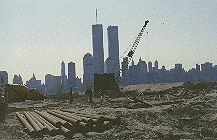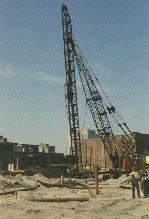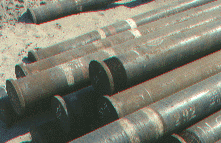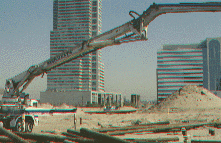

Manhatten skyline as seen from job
site
 A
visit to this site is a visual experience. One is treated to a first class
view of the downtown Manhatten skyline. a spectacle that most Manhatten
residents will never get to see.
A
visit to this site is a visual experience. One is treated to a first class
view of the downtown Manhatten skyline. a spectacle that most Manhatten
residents will never get to see.
The original design for this project was for approximately 250 piles to be 10 3/4" x .312" wall pipe and something short of 1,000 piles would be 8 5/8" x .322" wall pipe, all A-252 Grade III. The 10 3/4" pipe was to be used for piles in excess of 50 feet and the 8 5/8" pipe was to be used for piles 50 foot or shorter. Negative friction or downdrag was also a factor.
 Jack
Dougherty of DFP suggested to contractor Spearin Preston & Burrows
that they switch to 7 5/8" x .375" wall casing pipe for all the piles.
This pipe is sold as new reject pipe but has a minimum yield of 60 ksi.
The code allows 35% of the specified yield strength as a working load.
This pipe has a cross-sectional area of 8.54 in². 35% of 60 ksi is
21 ksi or a total working load for the steel of 179 kips. The pipe is filled
with 4 ksi concrete and the code allows 33% of the compressive strength
of the concrete. This pile has a cross-sectional area of concrete of 37.12
in² or a working load capacity for concrete of 49 kips, with a total
combined structural working capacity of 228 kips or 114 tons. Dougherty
also suggested that a 9 1/8" end plate be used to spread out the load on
the bearing material. The actual design load of the pile was 60 tons. All
piles were end bearing.
Jack
Dougherty of DFP suggested to contractor Spearin Preston & Burrows
that they switch to 7 5/8" x .375" wall casing pipe for all the piles.
This pipe is sold as new reject pipe but has a minimum yield of 60 ksi.
The code allows 35% of the specified yield strength as a working load.
This pipe has a cross-sectional area of 8.54 in². 35% of 60 ksi is
21 ksi or a total working load for the steel of 179 kips. The pipe is filled
with 4 ksi concrete and the code allows 33% of the compressive strength
of the concrete. This pile has a cross-sectional area of concrete of 37.12
in² or a working load capacity for concrete of 49 kips, with a total
combined structural working capacity of 228 kips or 114 tons. Dougherty
also suggested that a 9 1/8" end plate be used to spread out the load on
the bearing material. The actual design load of the pile was 60 tons. All
piles were end bearing.
7 5/8" piles with 9 1/8" end plates
attached
 This
change had several advantages. Reduced cost was of interest to all parties,
but in addition the smaller diameter pipe presents less surface area for
downdrag. The 8 5/8" pipe has 13% greater surface area and the 10 3/4"
pipe has a 41% greater area.
This
change had several advantages. Reduced cost was of interest to all parties,
but in addition the smaller diameter pipe presents less surface area for
downdrag. The 8 5/8" pipe has 13% greater surface area and the 10 3/4"
pipe has a 41% greater area.
Another big advantage was that this
site was filled. Many obstructions of unknown size were present in the
upper soils. The casing pipe is more capable of successfully penetrating
this material than the 8 5/8" or the 10 3/4" pipe originally specified.
 The
engineers accepted the 7 5/8" x 3/8" wall as a substitute for the 8 5/8"
but did not agree to a substitution for the 10 3/4" pipe. At first the
7 5/8" was limited to 50 feet. But when driving the indicator pile in an
area where the rock was thought to be 50 feet or less, some of these piles
went to seventy feet. It was agreed that 7 5/8" piles up to 70 feet were
acceptable. The 7 5/8" casing drove well even when obstructions were encountered.
However, some of the 10 3/4" pipe did not preform well and the damaged
10 3/4" pipe was replaced with7 5/8" casing pipe.
The
engineers accepted the 7 5/8" x 3/8" wall as a substitute for the 8 5/8"
but did not agree to a substitution for the 10 3/4" pipe. At first the
7 5/8" was limited to 50 feet. But when driving the indicator pile in an
area where the rock was thought to be 50 feet or less, some of these piles
went to seventy feet. It was agreed that 7 5/8" piles up to 70 feet were
acceptable. The 7 5/8" casing drove well even when obstructions were encountered.
However, some of the 10 3/4" pipe did not preform well and the damaged
10 3/4" pipe was replaced with7 5/8" casing pipe.
There were some 7 5/8" pipe piles used for marine work, and these were .430" wall pipe coated with coal tar epoxy.
Engineer - Langan Engineering
General Contractor - Procida Construction Corporation
Piling Contractor - Spearin Preston & Burrows, Inc.
Copyright © 1997-2017 Pileline Online. All Rights Reserved.